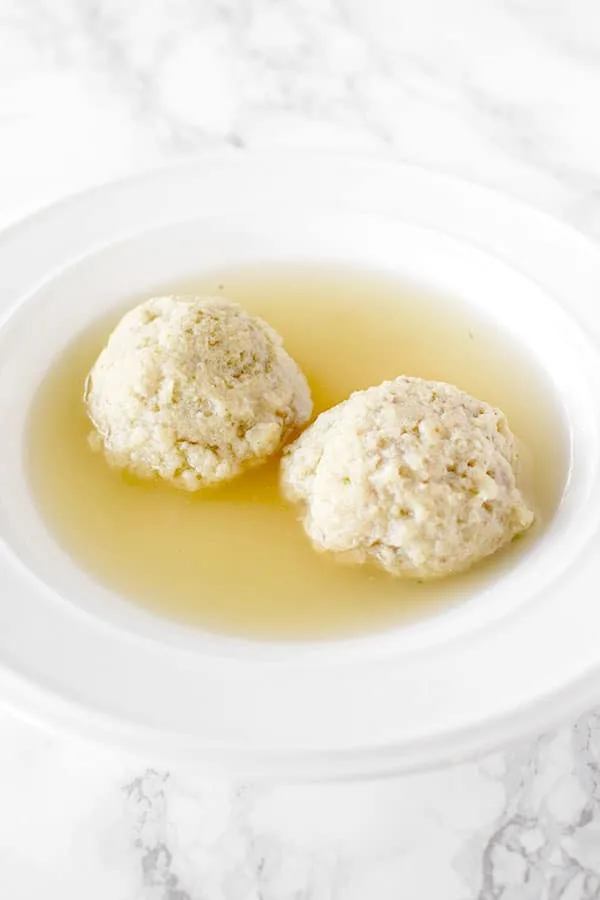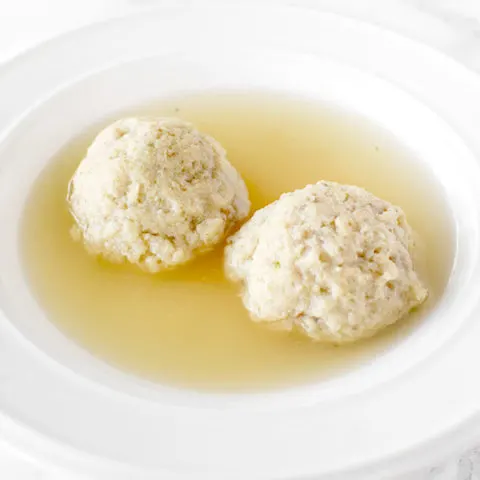These fluffy matzo balls are just like the ones you get out of the box, but made from scratch.
These matzo balls are also very simple to make and can be thrown together easily.

My family is pretty big on soups, and matzo ball soup is one of our favorites.
Growing up, my mom used to make the perfect matzo balls that were fluffy on the outside and a little firm on the inside.
I think I was a teenager or in my early 20s when I found out that she made it from packaged matzo ball mix.
Then, when I was 25, I moved to Israel and gone were the days where I had those perfect matzo balls.
Around Pesach, I did find the boxed stuff in the stores but I refuse to pay like $5 a box. No way, no how.
So, it became my goal to figure out how to make it myself.
All the recipes I tried that claimed to be fluffy were only fluffy enough to barely float - if even that.
Then, after some trial and error, I created my perfect matzo balls that are similar to what you'll get in Jewish delis.
They were great, but as my family pointed out, they weren't like the ones my mom used to make from the box.
So, my mom and I experimented until we got it just right, and these are them!
CAN YOU USE BAKING POWDER ON PASSOVER?
Absolutely! As long as the box is marked kosher for Passover with a “P” next to the kosher symbol.
I get this question a lot because of the fact that it is a leavener.
The truth is though, while laws regarding Passover are complex, the focus is on wheat flour rather than the leavener itself.
In fact, there wasn’t anything to leaven bread in ancient times except wild yeast.
So, the bread they were making was something of a sour dough bread.
This is the reason it took so long to rise.
BAKING SODA VS BAKING POWDER
Both baking soda and baking powder are leavening agents, which means that they help baked goods rise. However, they're not the same thing and they are not interchangeable.
Using baking soda instead of baking powder can give your recipe a terrible metallic taste, while using baking powder instead of baking soda leaves your baked goods looking flat.
BAKING SODA
When baking soda (also known as sodium bicarbonate) is combined with acidic ingredients and exposed to heat, it causes batter or dough rise and contributes to their light and fluffy texture.
However, baking soda is a versatile ingredient. It can be sprinkled over meat to tenderize it and it can be added to tomato sauce to neutralize the acidity.
Baking soda, when combined with an acid - such as cream of tartar, lemon juice, buttermilk, cocoa, and vinegar - creates carbon dioxide. When the carbon dioxide is released, it causes the familiar texture and crumb in pancakes, cakes, quick breads, soda bread, and other baked and fried foods.
A good rule of thumb is to use around ¼ teaspoon of baking soda per 1 cup of flour.
BAKING POWDER
Baking powder is created by combining baking soda, cream of tartar, and sometimes cornstarch.
Since baking powder already contains an acid, it's most often used when a recipe does not call for an additional acidic ingredient or calls for too little of one.
There are two types of baking powder. Single-acting baking powder and double-acting baking power.
Single-acting baking powder gets activated only once - when it gets wet.
Most baking powder sold is double-acting. This means that the leavening occurs in two steps.
The first is when the baking powder gets wet, which is why you cannot prepare some batters ahead of time to bake later. The second step is when the baking powder is exposed to heat, which happens when the batter is baked or fried.
A good rule of thumb is to use around 1 teaspoon of baking powder per 1 cup of flour.
WHY SOME RECIPES CALL FOR BOTH
Some recipes use both baking soda and baking powder because they need extra leavening that the baking soda alone cannot provide.
In these cases, baking soda provides an initial lift, while baking powder provides additional rise.
WHICH ONE IS STRONGER?
You may have already guessed the answer since baking soda is used to make baking powder and you need more baking powder per cup of flour. But I’ll tell you anyway.
Baking soda is four times stronger than baking powder.
That's why you will, more often than not, see recipes that only call for baking soda rather than recipes that only call for baking powder.
HOW LONG DO THEY LAST?
BAKING SODA
Baking soda is good indefinitely past its best by date, although it can lose potency over time.
A good rule of thumb is two years for an unopened package and six months for an opened package.
However, to be honest, I’ve used very old baking soda with good results.
BAKING POWDER
Like baking soda, baking powder is good indefinitely past its best by date, and can lose its potency over time.
For both opened and unopened, it’s ideal to use it within nine months to a year.
While storing it, make sure to keep it in a dry place and away from humidity.
HOW TO TEST IF IT’S STILL GOOD
BAKING POWDER
To test baking powder, pour 3 tablespoons of warm water into a small bowl, add ½ teaspoon of baking powder, and stir.
If the baking powder is good to use, it should fizz a little.
BAKING SODA
To test baking soda, pour 3 tablespoons of white distilled vinegar into a small bowl, add ½ teaspoon of baking soda, and stir.
The mixture should rapidly bubble if the soda is fresh.
THE BOX DOESN’T HAVE LIQUID IN THE RECIPE. WHY DOES YOURS?
I tried making it without the liquid, but it came out way too dry.
I think it’s because the box matzo mix meal is very fine, whereas regular matzo meal is coarse.
My guess is, the fine matzo meal doesn’t need as much liquid.
SCHMALTZ VS OIL
Schmaltz is the traditional fat used in matzo balls. However, in recent decades, oil has become at least as common.
While I usually use oil for convenience, many say that schmaltz elevates the flavor of the matzo ball.
MAKE AHEAD
Matzo balls can be made ahead of time.
Just cook them, remove them from the liquid, and refrigerate them in a resealable plastic bag or airtight container.
Refrigerate for 3 to 5 days.
FREEZE
You can freeze matzo balls on a tray and then move them to a resealable plastic bag or airtight container.
Freeze for up to 3 months.
After three months they are still safe to eat, but their quality begins to degrade.
Fluffy Matzo Balls

These matzo balls are light and fluffy just like what you get out of the box and are as easy to make.
Ingredients
- 1 cup matzo meal
- 2 teaspoons baking powder
- ½ teaspoon salt
- ½ teaspoon garlic powder
- ½ teaspoon onion powder
- 2 eggs
- ½ cup oil or melted schmaltz
- ¼ cup water
Instructions
- In a large mixing bowl, add matzo meal, baking powder, salt, garlic powder, and onion powder. Whisk to combine.
- Add eggs, water, and schmaltz or oil. Mix with a fork until combined.
- Let sit at room temperture for 20 minutes. Fill a wide pot with water or stock and bring to a boil.
- With wet hands, take some of the mix and mold it into the size of a ping-pong ball. Gently drop it into the boiling water. Repeat until done.
- Reduce the heat to a simmer. Cook 20 minutes or until a toothpick goes smoothly through a little passed the center of the matzo balls. Do not stir the pot until the matzo balls are done cooking or they will fall apart.
Nutrition Information:
Yield:
15Serving Size:
1Amount Per Serving: Calories: 136Total Fat: 8gSaturated Fat: 1gTrans Fat: 0gUnsaturated Fat: 7gCholesterol: 25mgSodium: 145mgCarbohydrates: 13gFiber: 0gSugar: 0gProtein: 2g
Ivy
Monday 23rd of October 2023
I followed this recipe to the letter Even used Schwartz and left them for an hour in the fridge. Soon as I put them in the boiling water they fell apart. My thoughts, more eggs, less baking soda.
Ascher Ward
Sunday 24th of March 2024
@ElissaBeth, according to your beginning entry you mention “chilling”. I too took it as refrigerating.
ElissaBeth
Monday 23rd of October 2023
It seems you followed the ingredient list to the letter but not the recipe. If you read the instructions, nowhere does it say let sit in the fridge for an hour. I'm not sure if that is what caused your problem or not, but I've never had that problem with this recipe before.
Lois Plotnik
Thursday 23rd of December 2021
Cold windy day here in Ontario, Canada so wanted to make matzo balls to go along with the large pot of Chicken Soup that I made yesterday. Found your recipe and decided to give it a try. I have always made sinkers for my soup so this is a bit different for me. Well, I must say, they are amazing. Large, fluffy and even on its own, pretty darn good. Thank you so very much for this one.
Wednesday 15th of January 2025
@ElissaBeth, Followed the recipe but turned out like mushy dumplings.
ElissaBeth
Thursday 23rd of December 2021
You're welcome! I'm so glad to hear you enjoyed it :)